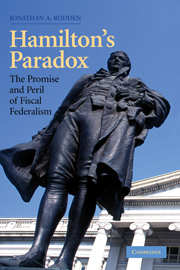Book contents
- Frontmatter
- Contents
- Preface
- Acknowledgments
- 1 INTRODUCTION AND OVERVIEW
- 2 PROMISE AND PERIL: INTELLECTUAL HISTORY
- 3 SOVEREIGNTY AND COMMITMENT
- 4 THE POWER OF THE PURSE: INTERGOVERNMENTAL GRANTS AND FISCAL DISCIPLINE
- 5 DISEASE OR CURE? POLITICAL PARTIES AND FISCAL DISCIPLINE
- 6 AN APPROACH TO COMPARATIVE CASE STUDIES
- 7 FISCAL FEDERALISM AND BAILOUTS IN POSTWAR GERMANY
- 8 THE CRISIS OF FISCAL FEDERALISM IN BRAZIL
- 9 THE CHALLENGE OF REFORM IN FEDERATIONS
- 10 THE ORIGINS OF SUBNATIONAL SOVEREIGNTY
- 11 CONCLUSIONS
- References
- Index
- Titles in the series
10 - THE ORIGINS OF SUBNATIONAL SOVEREIGNTY
Published online by Cambridge University Press: 14 January 2010
- Frontmatter
- Contents
- Preface
- Acknowledgments
- 1 INTRODUCTION AND OVERVIEW
- 2 PROMISE AND PERIL: INTELLECTUAL HISTORY
- 3 SOVEREIGNTY AND COMMITMENT
- 4 THE POWER OF THE PURSE: INTERGOVERNMENTAL GRANTS AND FISCAL DISCIPLINE
- 5 DISEASE OR CURE? POLITICAL PARTIES AND FISCAL DISCIPLINE
- 6 AN APPROACH TO COMPARATIVE CASE STUDIES
- 7 FISCAL FEDERALISM AND BAILOUTS IN POSTWAR GERMANY
- 8 THE CRISIS OF FISCAL FEDERALISM IN BRAZIL
- 9 THE CHALLENGE OF REFORM IN FEDERATIONS
- 10 THE ORIGINS OF SUBNATIONAL SOVEREIGNTY
- 11 CONCLUSIONS
- References
- Index
- Titles in the series
Summary
This book has made much of a distinction between fiscal sovereignty and semisovereignty among constituent units in federations. By the middle of the twentieth century in the United States, Canada, and Switzerland, voters and creditors had come to see the states, provinces, and cantons as sovereign debtors. On the other hand, detailed case studies of Germany and Brazil in the 1980s and' 90s analyzed what can go wrong in federations where subnational entities are semisovereign: They are allowed to borrow freely even though fiscal and political institutions send strong signals to voters and creditors that the central government can ultimately be held responsible for their debts. Yet a more basic set of questions remains unanswered: Why do the institutions that bolster subnational fiscal sovereignty – above all, a limited center and wide-ranging subnational tax authority – so often slip away? In the long run, why do some federations maintain distinct spheres of fiscal sovereignty among the constituent units while others do not?
All modern countries are artificial constructs put together by a combination of brute force and bargaining after a long period in which the only sovereignty – political or fiscal – extended to small communities. At the beginning of the twentieth century, state and provincial governments resembled fiscal sovereigns in Argentina, Australia, Brazil, Canada, Germany, Mexico, Switzerland, and the United States, among other federations, and the same can be said about local governments in many unitary systems.
- Type
- Chapter
- Information
- Hamilton's ParadoxThe Promise and Peril of Fiscal Federalism, pp. 250 - 268Publisher: Cambridge University PressPrint publication year: 2005



